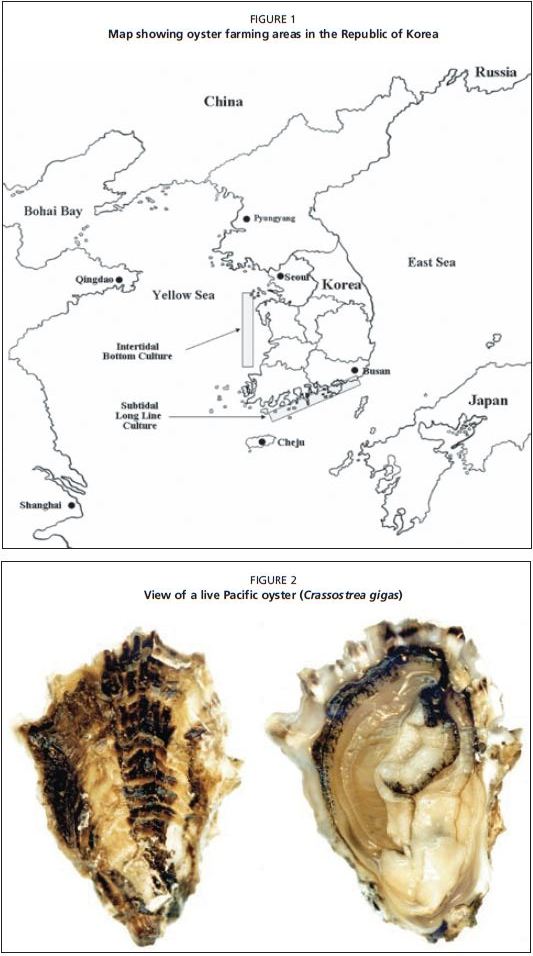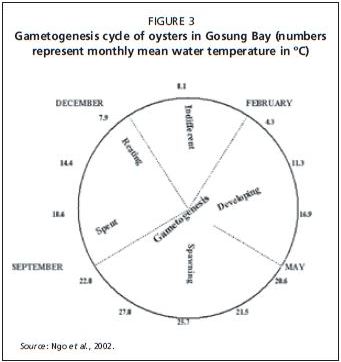ECOLOGY OF CRASSOSTREA GIGAS
Nomenclature
Scientific name:
Class Bivalvia
Order Ostreoida
Family Ostreidae
Crassostrea gigas Thunberg 1793 (Figure 2)
Common name:
The preferred common names are the Pacific oyster and Pacific cupped oyster. Other common names include the giant Pacific oyster and the Japanese oyster.
Distribution range in Asia
Crassostrea gigas is found in the west, south and east coast of the Korean Peninsula, Northern Bohai Bay of China to China Hong Kong Special Administrative Region (SAR), from Okinawa to Hokkaido in Japan and from Vladivostok to the Kamcharka Peninsula, Russia.
Figure 1
Map showing oyster farming areas in the Republic of Korea
Figure 2
View of a live Pacific oyster (Crassostrea gigas)

Figure 3
Gametogenesis cycle of oysters in Gosung Bay (numbers represent monthly mean water temperature in ?C)

Source: Ngo et al., 2002.
ovary and testis are displayed in Figure 4.
Annual gametogenesis
Ngo, Kang and Choi (2002) reported a match between seasonal changes in the surface seawater temperature and gametogenic changes in the Pacific oysters in Gosung Bay off the southeast coast of the Republic of Korea (Figure 3). Crassostrea gigas in the Gosung Bay commences gametogenesis in February when the water temperature reaches 4–7 ?C. In late May to early June, oysters become fully mature and ready to spawn. The diameter of fully mature oocytes varies from 50–70 ?m. Spawning occurs as early as mid-June and can continue until the end of September when the temperature ranges from 23–26 ?C. Abrupt changes in water temperature and salinity induce spawning in oysters. Microscopy photographs of both the
According to Kang et al. (2003), oysters in Gosung Bay spawn twice a year, once in late June and again in late July to mid-August. During spawning female oysters may discharge as much as 60 percent (average 40 percent) of their body weight as eggs. The spawning intensity and quantity of egg released from single oysters is greater in the first spawning peak which is late June (Figure 5). The fecundity of the oysters in Gosung Bay varies from a few million to 200 million eggs during the spawning season.
Larval development
Figure 6 shows the development of the trochophore stage from the pear-shaped mature oocytes released from spawning oysters. The first polar body forms between 50 to 70 minutes after fertilization when water temperature ranges from 20–21 ?C. The morula stage can be observed 3 or 3.5 hours after fertilization, while the rotating blastula larva appears between 5 and 6 hours following hatching. Fifteen to twenty-eight hours after fertilization the oyster D-shape larvae develops and, depending on the water temperature, the fully grown larvae (300–350 ?m) appear in the water column 10 to 20 days after fertilization and subsequently settle on fixed substrates (Figure 7).
Temperature and salinity are the two key environmental factors that govern larval development. Numerous studies have demonstrated that low water temperatures and salinities slow down larval development, while higher temperatures shorten the duration of the larval period. According to Yoo and Yoo (1972), it takes approximately 10 days from fertilization to settlement when the water temperature remains above 27 ?C. However, it takes more than 3 weeks from the fertilized egg to settlement when the water temperature ranges between 19–20 ?C.